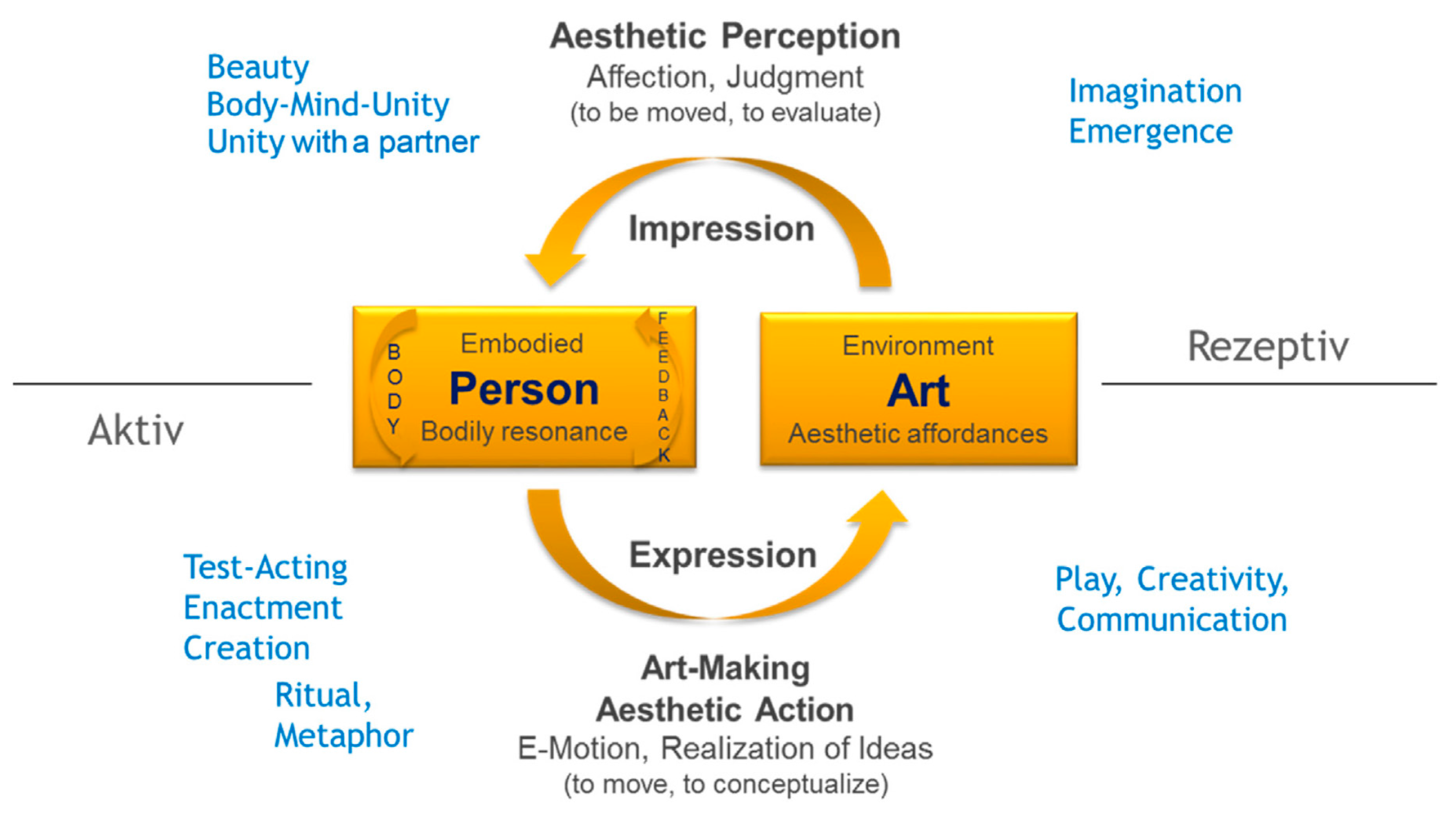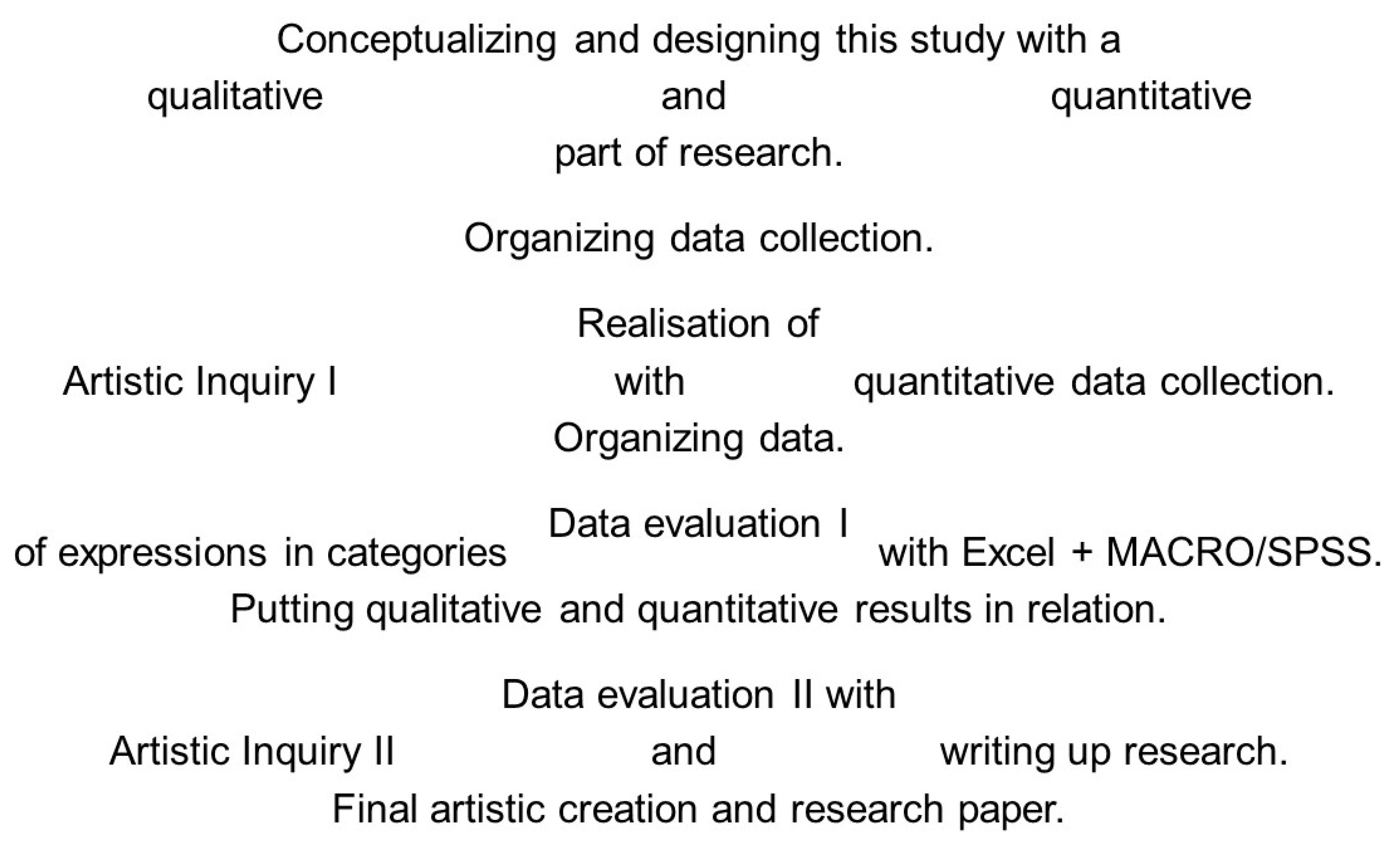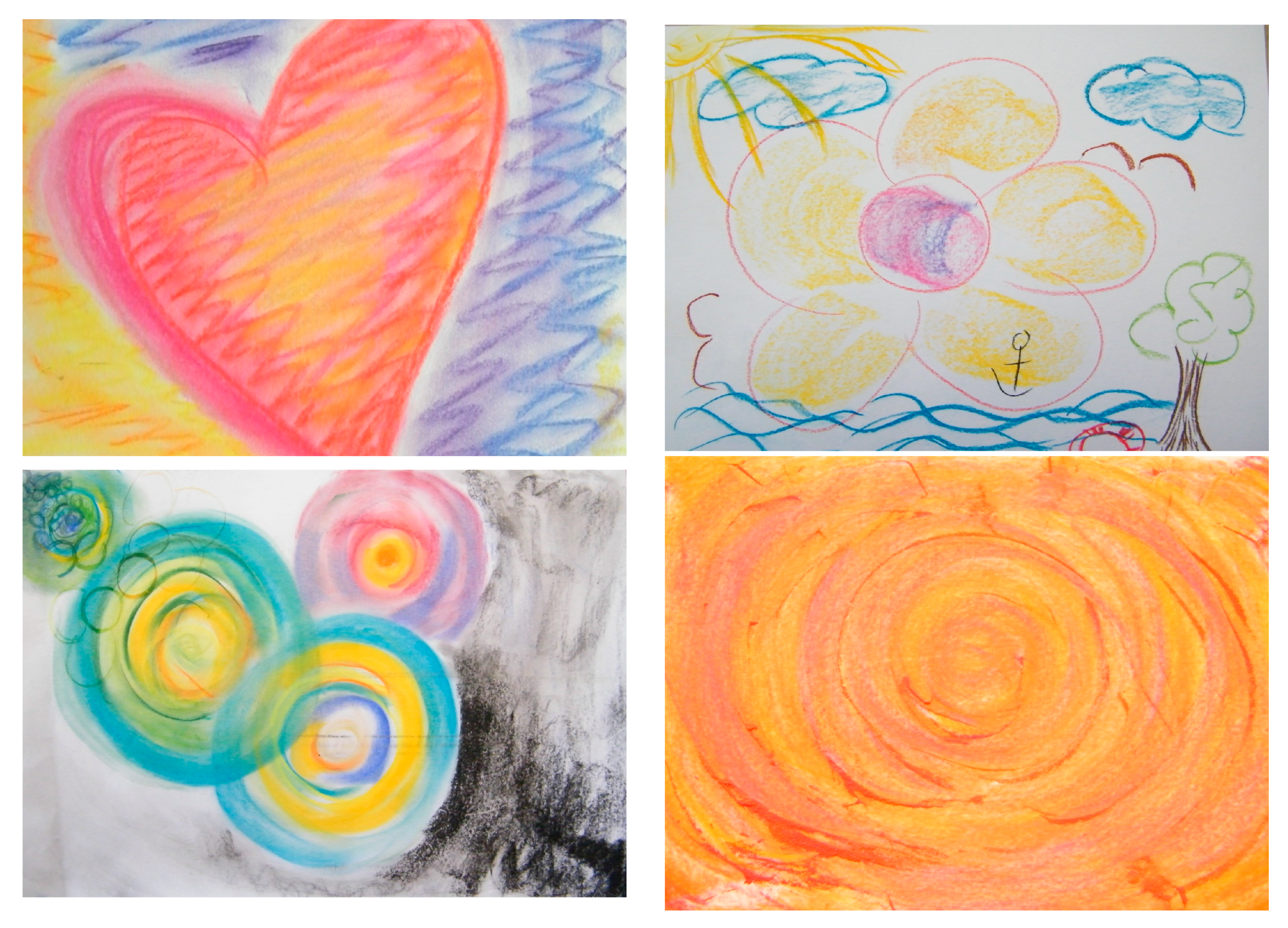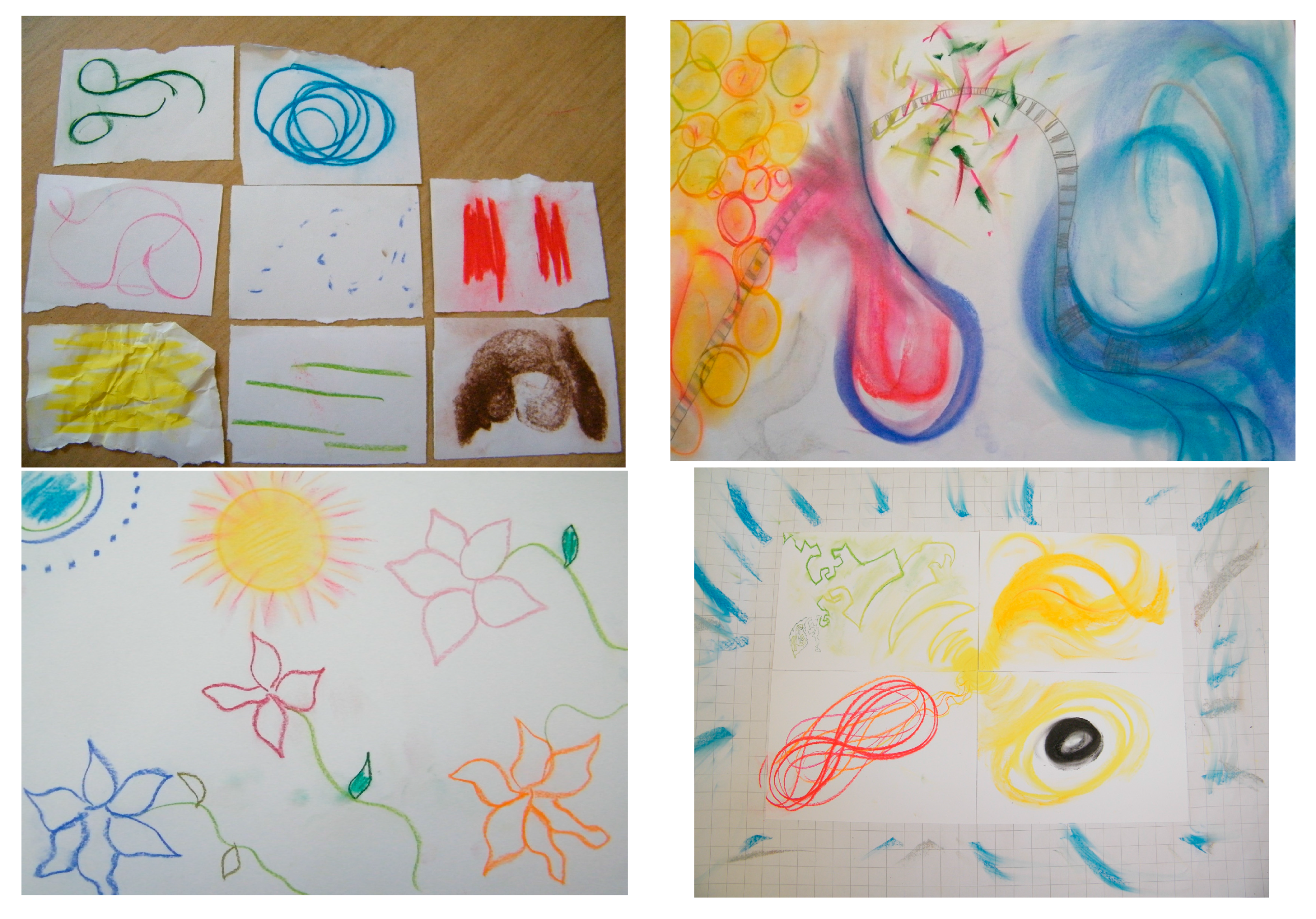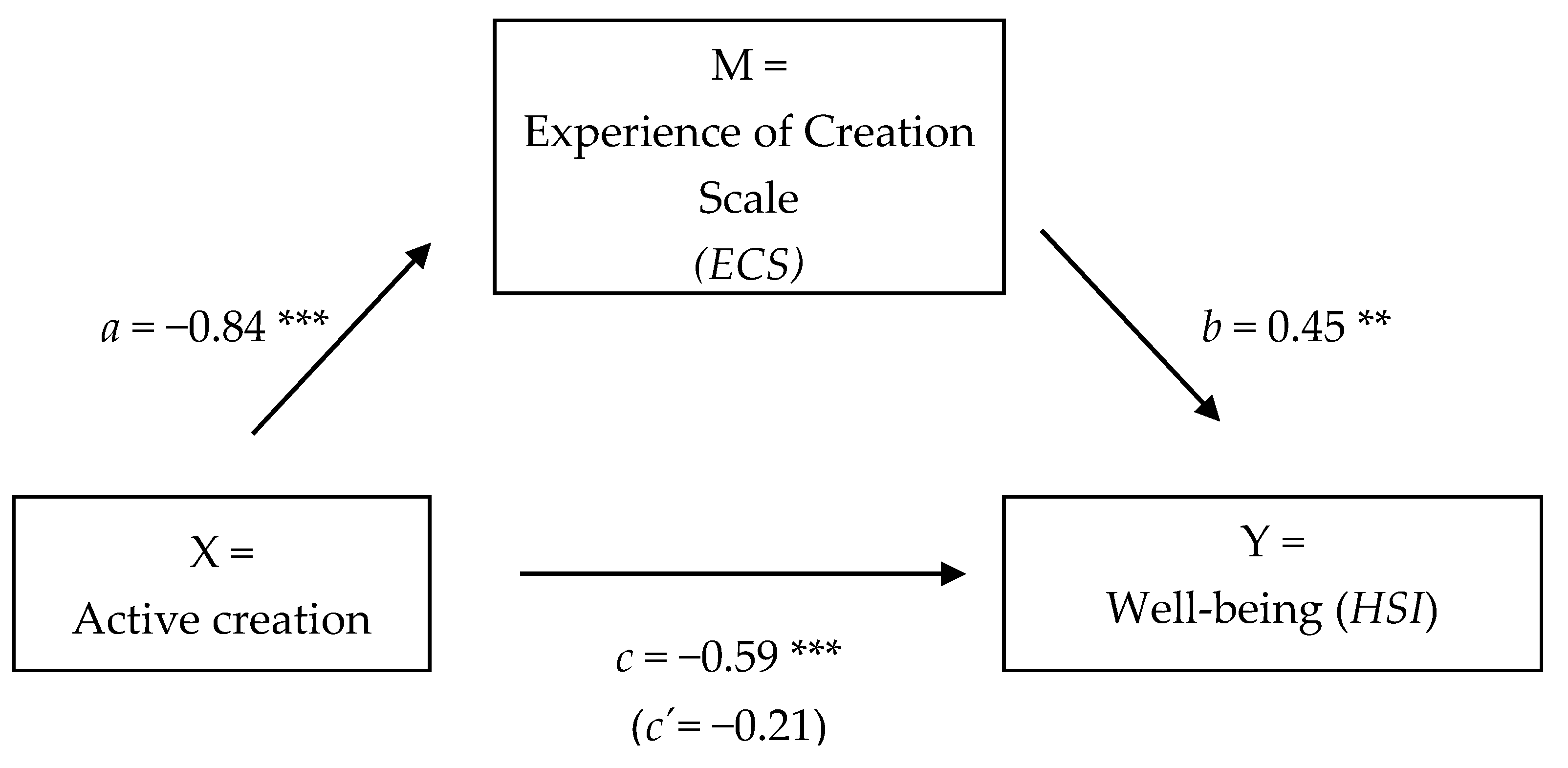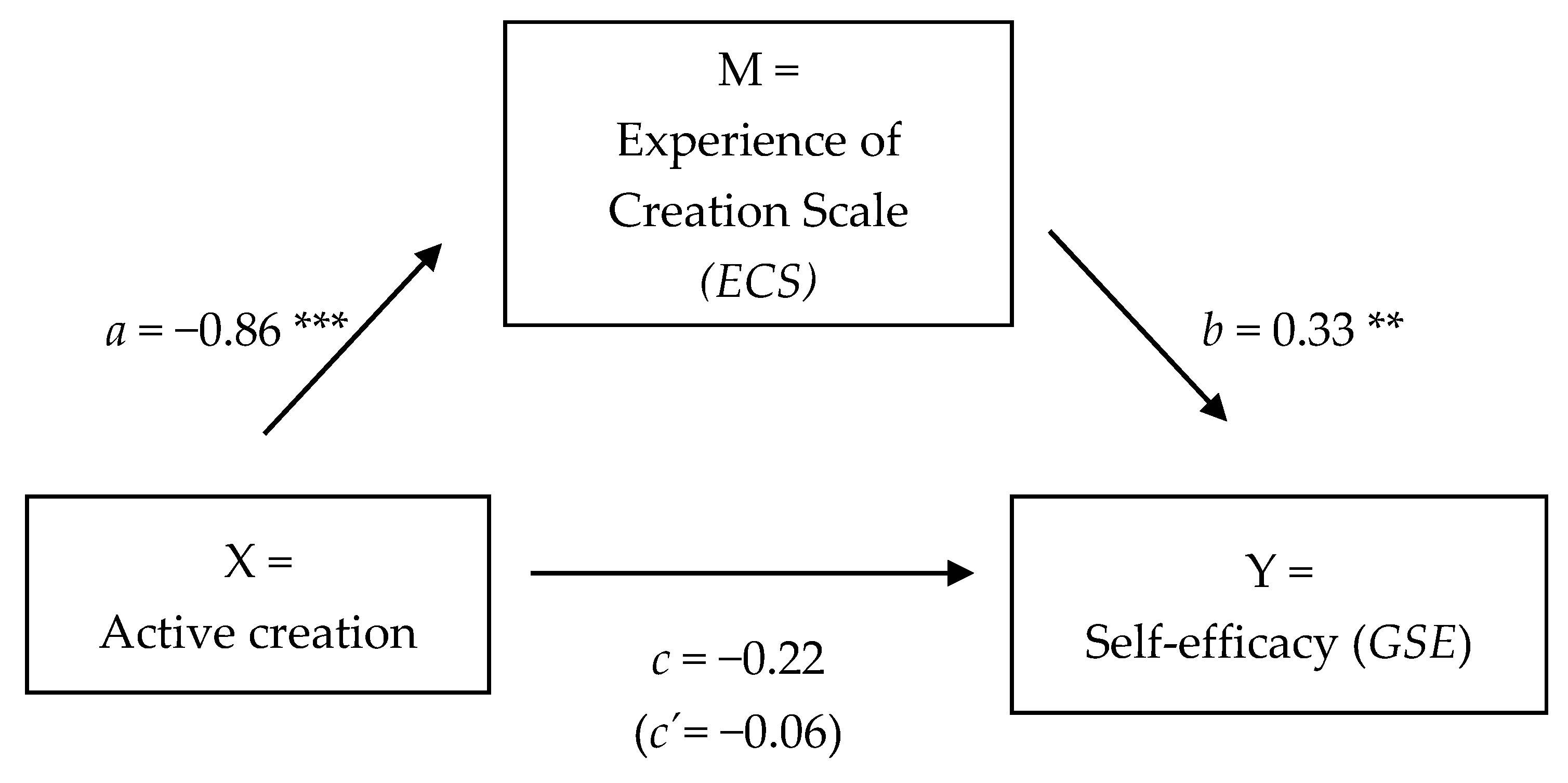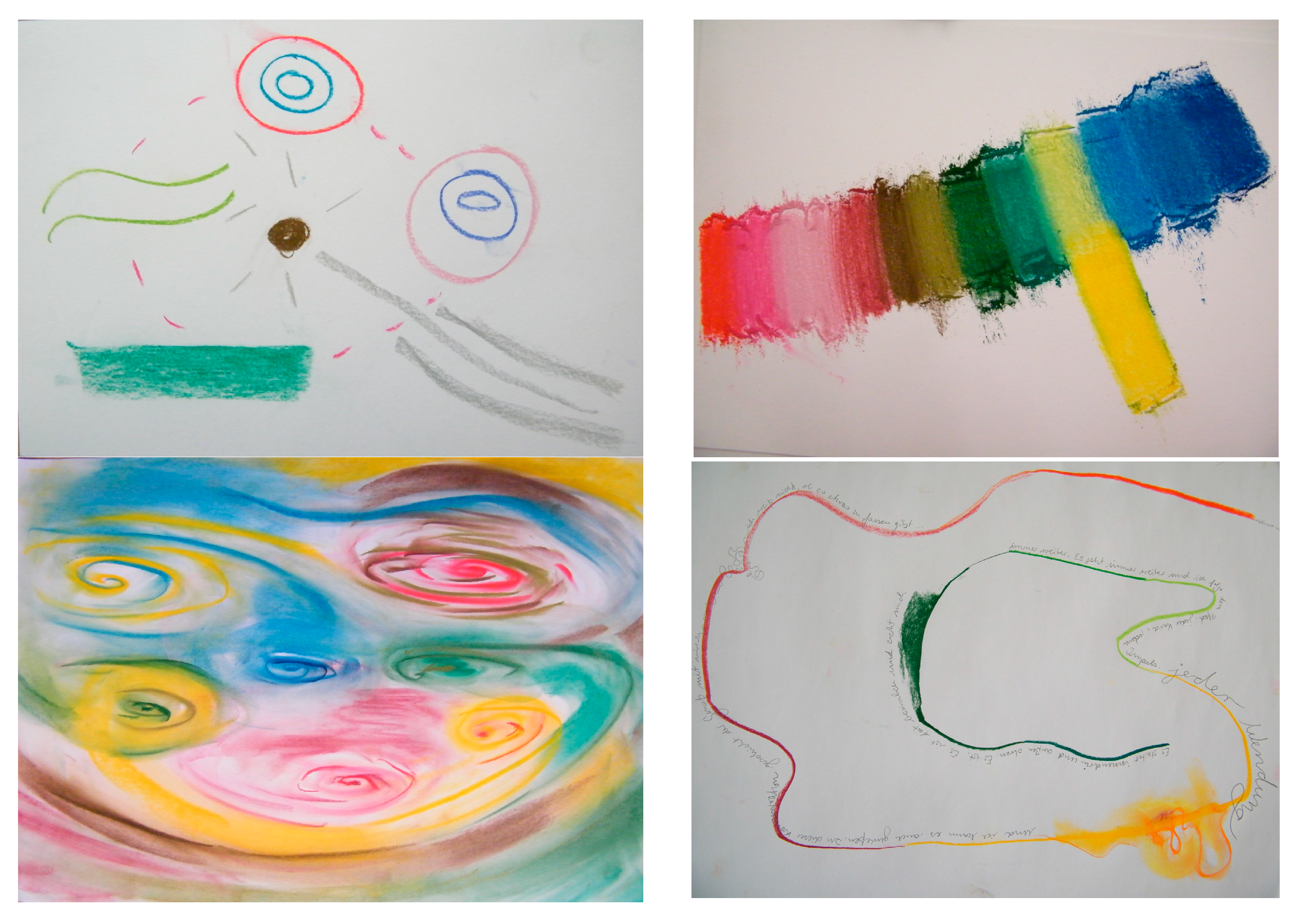The study was set up as a mixed-methods design as described in
Figure 2. We used a concurrent combination of two state-of-the-art methods for analyzing questions on working factors/mechanisms: mediation analysis [
19], as recommended by the National Institute of Health (NIH) of the USA for analysis of therapeutic mechanisms in the (integrative) health sciences, and artistic inquiry as a state-of-the-art method development unique to the arts therapies. Within an experimental frame, artistic inquiry was used for qualitative data collection and analysis [
20], and mediation analysis for quantitative data analysis [
19]. A triangulation approach was implemented to let the methods inform each other. The researchers take a humanistic clinical stance and a transformational epistemological stance (compare Creswell & Creswell [
21]; Mertens & Hesse-Biber [
22]).
2.1. Sample
Forty-four participants (7 men, 37 women) took part in the study at SRH University, Germany. The sample consisted of students of dance movement therapy, music therapy, and occupational therapy, with a mean age of 25.98 years (standard deviation: SD = 6.67, age range: 19–52). They were divided into an experimental group (EG,
N = 21; 19 women and 2 men) and a control group (CG,
N = 23; 18 women and 5 men). See
Table 1 for details on demographic data. Power estimations indicate that in a model with one mediator,
N = 44 participants reach a power of 0.81 (with an aspired power of 0.80 in this feasibility study), assuming correlations of
r = 0.7 between the independent variable
X, the dependent variable
Y, and the mediator
M (estimated with the online-tool by Schoemann and colleagues [
23]:
https://schoemanna.shinyapps.io/mc_power_med/).
We announced the experiment, using students’ mailing lists of SRH University, and went into students’ courses and addressed students directly on-site at SRH campus during their breaks. A mailing list was created, and a doodle calendar with an invitation to participate was sent out. We announced that the study takes a closer look at creating, that they should have previous experience with artistic media, that the participants would need to improvise alone in an individual setting choosing movement, music, colors, and/or words, that the researcher would answer in an improvisation, and that there would be questionnaires to complete. We advertised that we would provide chocolate bars and course credit (certificates of participation hours needed by students) as a reward. In order to recruit as many participants as possible, students could inscribe using a doodle calendar. The sample was thus not randomized, but t-test and Chi-square test yielded that there were no significant baseline differences between EG and CG (all p-values > 0.279). We identified three systematic outliers in the EG for the outcome of well-being and excluded them in the according analyses. Thus, 41 participants (19 EG, 22 CG) remained in the analysis of well-being, and 44 participants (22 EG, 22 CG) remained in the analysis of self-efficacy. The CG participants participated in one of two regular classes (either on theories and techniques of supervision or conceptualization of health and sickness) completing the identical questionnaires at the beginning and in the end of the class. They were contacted through their professor, and the researcher (first author) was present before the start of their classes to raise attention for the study and clarify questions.
2.2. Procedure
The individual settings were conducted in a 75 m
2-music therapy room at SRH University Heidelberg. It was equipped with mats, a lounge area, materials for visual arts, and 62 instruments. Two video cameras and an audio recorder were prepared (for exact lists for replication purposes, please contact first author.) EG participants were welcomed. If they did not know the space, they were invited to look around and get acquainted with the environment. Then, the participant was asked to sit down with the researcher in the lounge area in order to be introduced to the study. The participant signed the informed consent sheet and filled out the first questionnaire (t1) after receiving information about coding. Then the researcher gave a short introduction, asked her counterpart what the term “Gestalten” (creating) means for him or her and ended with a description of what to expect following a protocol (please contact the first author for German original instructions.). Participants were asked to improvise with movement, music, colors and/or words for a maximum of eight min. They were allowed to use any media and could also stop earlier (see
Figure 3,
Figure 4, Figures 7 and 8 for illustrating examples of resulting visual art creations). Timing was controlled, movement videotaped, and music recorded. The opening question for the improvisation was: What happens inside yourself when you create?
Afterward, participants and researcher (GL) independently phrased an expression in written words about what they just had experienced followed by a verbal exchange. A questionnaire was then filled in for the second time (t2). As a further step, the researcher improvised in reaction to the participant’s improvisation under the same conditions (8 min; all media). Again, participant and researcher phrased an expression capturing their experience, had a verbal exchange, and the questionnaire was then completed for the last time (t3). Ending the session, participants could choose from a choice of chocolate bars. We concurrently provided the certificates of participation hours, debriefed the participants, and thanked them for attending. One session took about 45 to 50 min. CG participants followed regular class without artistic creating and completed two questionnaires at t1 and t2. These two measurement points in EG and CG, served in the quantitative analyses reported here.
2.3. Materials and Instruments
The room was prepared with four pieces of paper. At each wall one of them was attached reading either “Movement” or “Music” or “Words” or “Colors/Forms”. The offered musical instruments were a timbale, a drum set, a kettledrum, 5 congas, 3 djembés, 2 tambourines, a vibraphone, a marimbaphone, a xylophone, a glockenspiel, 6 boomwhackers, 6 chimes, a metallophone, a bass chime, a tomtom, a tympanum the size of a table, a bigbom, 4 claves, a temple block, a pair of maracas, a cabaza, 2 caxixis, a cajon, a triangle, an agogobell, a gong, a singing bowle, a thumb piano, an ocean drum, a kazoo, a rain maker, a piano, a guitar, a bowed psaltery, a lyre, a monochord, an accordion, an aerophone, a soprano recorder, an alto recorder, and a slide whistle. The offered visual arts materials were normal paper in A3, thicker paper in A4, 3 pens, 28 wax oil crayons, 12 water color pencils, 24 pastels, different qualities pencils with eraser, and a sharpener. Technical devices were a Zoom H2n audio recorder, a canon camcorder (Legria HF20) (Uxbridge, UK), and a Fujifilm camera (Finepix S1800) (Minato-ku, Tokyo, Japan).
Well-being was measured with the Heidelberg State Inventory (HSI; [
15,
16]; see
Appendix A). The six dimensions of positive affect, coping, fear, depressive affect, tension, and vitality were assessed each with four items. Two items were phrased in correspondence with the positive pole of the dimension, two items were inverted. A vitality-item was “Right now I feel full of energy”. An inverted fear-item was “Right now I feel without sorrow”. These items are to be rated on a scale where “1” means “very low well-being” and “5” “very high well-being”. In this study, the
HSI showed a high internal consistency of Cronbach’s α = 0.95.
Self-efficacy was measured with the General Self-Efficacy Scale (GSE; [
18,
24]). Sample items are “When I am confronted with a problem, I can usually find several solutions. “or “If I am in trouble, I can usually think of a solution”. Ten items are rated on a scale from “1” ”not at all true” to “4” “exactly true”. Internal consistencies in international studies resulted in Cronbach’s α = 0.86 in a sample of
N = 19.120 [
25], the same value resulted in this study.
For this study, the Experience of Creation Scale (
ECS; [
26]) has been designed consisting of four items (see
Appendix B). These items are “Right now I feel empowered”, “Right now I feel free to decide”, “Right now I feel I have impact”, and “Right now I feel creative” (translated by first author). Participants rated these items on a scale from “1” meaning “not at all true” to “5” meaning “exactly true”. Its internal consistency was Cronbach’s α = 0.89.
The opening question at the start of the improvisation was: What happens inside yourself when you create? The reflective question after creation was: What did you experience while creating? In both cases, the active person had approximately two minutes to write an answer. Resulting statements were collected.
2.4. Statistical Analysis
The new measure
ECS was tested with factor analysis and reliability analysis. For between-group effects, we computed a repeated measures ANOVA using the Greenhouse-Geisser-value controlling for problems with sphericity. The alpha-level was set at 0.05. To determine correlations between scales, we used Pearson’s correlation coefficient. Mediation analysis [
19] was conducted in order to determine the effect of
ECS. Mediation analysis is based on regression analysis. Both the indirect and direct effect of the independent variable (
X) on the outcome variable (
Y) are being reported and interpreted. The indirect effect
ab is the product of the regression coefficients of the regression of
X on the mediator variable (
M)
a and the regression of
M on
Y b. The direct effect is called
c′. For mediation analysis, we conducted multiple linear regression analyses with the Macro PROCESS for SPSS 22 (IBM Corporation, Armonk, NY, USA) from Hayes [
19]. For all effects, we report unstandardized regression coefficients [
19]. We used bias-corrected boot-strapping obtained with 10,000 resamples [
19].
